Starting
out
in Underwater Photography
Underwater housings, pressure, and swimming underwater.
You don't need to be an expert photographer or a SCUBA diver
to
take underwater photographs or use a video camera underwater; but if
you're new to the game, this section might help you to understand what
all of the equipment does and give you an idea of how to use it and
look after it.
Housings
Any piece of electronic or delicate mechanical equipment destined to be
used underwater requires a housing, i.e., a sealed box or casing
designed to prevent the water from getting in. The housing can either
be part of the equipment, such as the casing of a waterproof camera; or
it can be a separate item designed to enclose a piece of equipment that
is not otherwise waterproof. There are two basic types of
housing: flexible housings, and hard (or pressure-resistant) housings.
In the examples shown below; 'A' is a compact camera inside a
pressure-proof housing, 'B' is a waterproof camera with its own
integral pressure-proof housing, and 'C' is a camera inside a flexible
housing.
So, what's
all this about pressure?
If you take a rigid box underwater and then make a small hole in it,
the water will not dribble in, but squirt in, with a force that
depends on how deep you are. This phenomenon is due to the weight of
the water above you. On the surface of the planet, we are always under
pressure due to the weight of the atmosphere above us, but we don't
usually notice it because the air-spaces inside our bodies are at much
the same pressure as the air outside. The only times when you might
notice the effects of changing air pressure are when driving from the
top to the bottom of a large hill, or in an aeroplane that is coming
in to land; in which case, your ears start to feel strange until you
yawn or move your jaw about. This is because, unless you have a very
bad cold, the body has only two air-spaces that are not normally open
to the outside, and these are behind the ear-drums in a place known as
the 'middle ear'. The middle-ear has a tube leading to the throat,
called the 'Eustacian tube', which is opened and closed by a small
muscle called a 'dilator muscle'. The dilator muscle operates when you
yawn, to keep the pressure on both sides of the ear-drum approximately
the same so that you can hear properly. You'll need to make friends
with your Eustacian tube dilator muscles when you learn to dive or
snorkel.
When you dive
underwater, the problem of
increasing pressure is much more severe than when you lose height in
the air, because water is much denser than air. The air pressure varies
slightly due to the weather, but on an average day, the pressure of the
atmosphere, due to the weight of the column of air between the surface
of the earth and interplanetary space, is only the same as the pressure
due to about 9.9 metres of water. It's not so much the absolute
pressure
we're interested in however, but the pressure difference between the
inside and outside of any box or vessel (or ear-drum).
When you close a
rigid box on the
surface, the pressure inside is fixed at about atmospheric pressure.
For convenience, we can refer to this pressure as 'one atmosphere'.
When you swim down to a depth of about 10 metres, the pressure inside
the box is still only at one atmosphere (or even less if the water has
caused the air in the box to cool down) but the pressure outside is 2
atmospheres, i.e., the pressure due to the atmosphere
plus
the
pressure due to the water. The pressure difference however, between the
inside and the outside of the box, is one atmosphere. In general, the
pressure difference increases by approximately one atmosphere for every
10 metres
(10m) of depth, i.e., at say 30 m, the pressure difference between the
inside and the outside of the box is about 3 atmospheres, but the
absolute pressure (water + air above) is 4 atmospheres.
The above examples
were chosen for their
nice round numbers. There is nothing magical about the pressure of one
atmosphere, and it takes only a tiny fraction of that to cause a
housing to leak. In fact, the cooling effect of plunging a housing into
water (which makes the air inside want to contract) is enough to cause
a leak without going to any depth at all. Fortunately, it is down to
the engineers who design underwater housings to solve this problem for
you, but given the enthusiasm with which the water wants to get in, the
engineers can't help you if you don't take the business of closing the
housing seriously.
Flexible
housings
One solution to the pressure problem is to make the housing flexible.
The housing can then simply contract (reduce in volume) to keep the
pressure on the inside and the outside the same. This is a very
reliable system, because the lack of any pressure difference means that
there is no real tendency for the housing to leak. This system is also
very simple, because the controls of the equipment inside the housing
can mostly be operated through the flexible plastic. There are
limitations to this approach however, because as you go deeper, there
will come a point when the housing clings tightly to whatever is inside
it, the housing won't be able to shrink anymore, and a pressure
difference will begin to appear. Consequently, flexible housings still
need to have a pressure-resistant sealing system. The ewa-marine
housing shown above uses a metal clamp, held together by
hand-tightening screw-fasteners ('hand-wheel nuts'). Closing the
housing is a matter of making sure that the two surfaces that will be
clamped together are clean, since dirt, and particularly hairs, can
make microscopic channels through which the water can creep. Cleaning
the surfaces is simply a matter of wiping them with a lint-free cloth
or paper towel, and inspecting them carefully before fitting the clamp.
When assembled properly, the sealing system, and the tough flexible
plastic material, can withstand large pressures, 30 or 40 metres of
water, and the real limitation is that of how much punishment the thing
inside the housing can take. With cameras, there comes a point at which
the
water starts to press buttons that you don't want pressed, and so the
recommended depth limit for flexible housings is usually (but not
always) about 10 metres.
Flexible housings are
available for
cameras, video cameras, personal effects and valuables (so you can
take them with you into the water), mobile phones and VHF radios (in
case you fall into the water), maps and charts, etc.
Hard, Rigid,
or Pressure-Resistant Housings
Hard housings, whether part of a camera, or a separate box into which
the camera must be installed, are nearly always sealed by means of a
device called an O-ring. In fact, there will be an O-ring seal for
every control, and every plug, socket, or window, in the housing, but
the user is mainly concerned with O-rings (such as the one around the
door that gives access to the camera) that have to be disturbed in
some way while the equipment is being prepared for use.
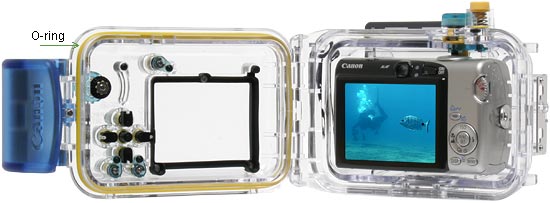
The O-ring itself is simply a rubber band, usually of circular
cross-section, but manufactured to high tolerances so that it is free
from nicks, holes, and other defects that might let the water into the
housing. The O-ring is also made of a particular type of rubber (there
are lots of types), chosen for its chemical resistance and hardness,
and it is not a good idea to use a substitute unless you know what you
are doing.
The 'O-ring seal' is the combination of the rubber ring and a specially
shaped groove, which is designed so that, when the housing is placed
under pressure, the ring is forced into the gap through which water is
trying to pass.

O-ring with no pressure difference |
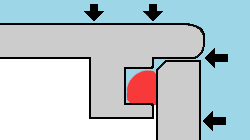
O-ring under pressure |
The cute thing about this system is that the seal actually
gets
tighter as the pressure increases; which means that the seal is
inherently reliable, provided that the O-ring and the O-ring groove are
kept in good condition and are kept thoroughly clean while the housing
is being closed. This is the most important thing you need to know
about underwater photography with hard housings, because bad husbandry
in this department can lead to serious disappointment, whereas bad
photographic technique can be rectified with practice. There is nothing
difficult about assembling an O-ring seal however; it is simply a
matter of cleaning the O-ring and the groove with a paper towel,
inspecting the surfaces for dirt and hairs, and, for the type of seal
shown above, applying a very thin coating of grease to the O-ring. The
grease used on O-rings incidentally, does not form part of the seal;
its job is simply to make the O-ring slippery so that it can slide into
position without being damaged.
Most manufacturers
opt for the
hard-housing approach to underwater equipment design, and a wide range
of camera housings, lights, flash units, and torches
are available, with depth ratings from a few metres to over 100 metres.
You
can find out more about underwater photography by reading the
other articles in this website, and by looking-up terms you don't
understand in the
glossary.
Going
underwater
| There are a few people who decide that they would like
to
take underwater pictures but have, up until that point, always kept
their eyes tight shut when going under the surface. It is important to
know therefore, that the human eye cannot focus underwater. In order to
be
able to see the camera viewfinder, it is necessary to place an
air-space between the eye and the water. A pair of swimming goggles
will do the trick at shallow depths; but these can cause injury at
depths of only a few metres because they lack any means of pressure
equalisation. Plastic goggles also tend to become
scratched and battered, and you will be able to see much more clearly
if you obtain a proper diving mask with toughened optical-glass lenses.
You can obtain such a mask from any diving equipment supplier, but you
should also seek advice on choosing the right size
and proper fitting. |
 |
Masks and goggles also tend to mist up,
and clarity
of vision is much more important for photographic diving than for any
other type of diving. A solution to this problem is to apply the
tiniest amount of shampoo to the inside of the lens, and wash it around
with a little water. Since traces of the detergent will inevitably
end-up in your eyes, you must use a shampoo that doesn't cause the
eyes to sting for this purpose, i.e., baby shampoo (based on sodium
lauryl
ether
sulphate SLES), or the type of
shampoo for which you have to pay extra to have the noxious chemicals
left
out. Don't use medicated shampoo, conditioning (i.e., oily) shampoo,
and don't be tempted to use washing-up (dish) detergent (SLS) or
ordinary
soap. If you have no shampoo with you, saliva (spit) is the traditional
diver's de-fogging agent, but it is not as effective as detergent.
You can take
perfectly good photographs
by putting your head just under the water; but to add a feeling of
drama to a photograph, it is sometimes desirable to be on the same
level as, or below, the subject. This means that you will need to learn
how to dive or snorkel, and this brings us back to the subject of ears.
One of the golden rules about swimming under the water is that
there
is no acceptable level of pain.
Your Eustacian tubes will not work very efficiently if you have a cold;
and people often have low-grade throat infections that produce little
in the way of symptoms except for difficulty in opening the Eustacian
tubes. The Eustacian tubes of children also tend to be inefficient, but
these problems usually resolve naturally by the time that children
reach
their teens. If your Eustacian tubes do not open as you dive down, you
will experience discomfort at a depth of about 0.5 metres, and actual
pain at a depth of about 1 metre. The only way to resolve this problem
is to go back to the surface and try again. If you carry on down, the
pain will not go away because the pressure difference between the
middle-ear and outside will hold the Eustacian tube shut, and you will
eventually reach a point at which one of your ear-drums will burst.
 Don't do it
Don't do it
- learn how to get your Eustacian tubes to work instead.
Opening of the
Eustacian tubes is
normally a part of the yawning and swallowing reflexes, which is why
it's a good idea to feed babies while an aircraft is coming in to land.
You can actually yawn without opening your mouth, and you might try
learning how to do this (out of the water) and using this trick when
you dive. When the Eustacian tube to a particular ear opens, you will
hear a 'click' in that ear. If you hum a note at the same time, the
sound of the humming will become loud as the air-channel between the
ear and the throat opens. With practice, you might find that you can
get the opening of the tubes under conscious control, and separate it
completely from the yawning reflex; after which, diving will become a
cinch. If all else fails however, you can resort to a procedure known
as the 'Valsalva manoeuvre', which involves holding your nose and
blowing (you must also close your mouth or block your snorkel with your
tongue). Diving masks normally have provision for holding the nose from
the outside, so that the Valsalva manoeuvre can be performed while
wearing a mask; but it is not a good idea to perform this procedure too
vigorously if you have a cold, because you may introduce bacteria into
your middle-ear and cause a painful infection (and temporary deafness).
The Valsalva manoevere should anyway, only be performed gently and
tentatively, with just enough pressure to achieve the desired effect.
Coming up from depth incidentally, is hardly ever a problem, because
the closed Eustacian tube acts as a one-way valve; one of its natural
rôles being to allow fluid to drain easily out of the
middle-ear, but
make it difficult for things to get in.
You can find out more about underwater swimming and diving by
contacting training organisations and clubs in your local area. If you
are planning the diving holiday of a lifetime, you will find that you
get the most pleasure from it by taking a training course at home
before you go.
You can find out more
about underwater
photography by reading the other articles in this website. If
you don't know what a particular technical term or abbreviation means,
there is a good chance that it will have been added to the glossary.
© David W Knight.
2001, 2002, 2012, 2018, 2019.


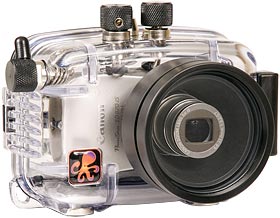
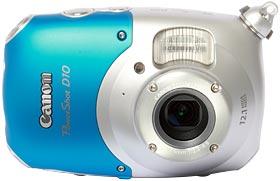
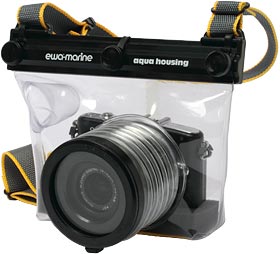

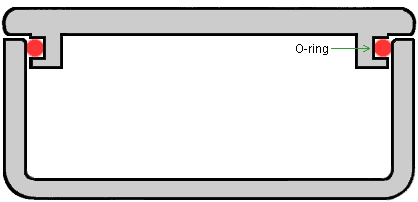



 Don't do it
- learn how to get your Eustacian tubes to work instead.
Don't do it
- learn how to get your Eustacian tubes to work instead. 


